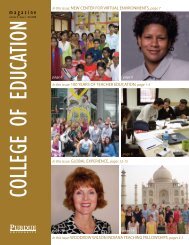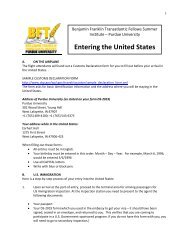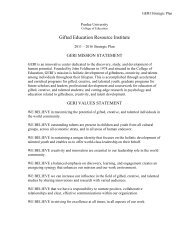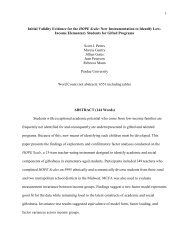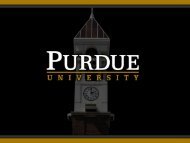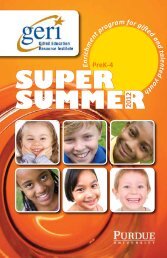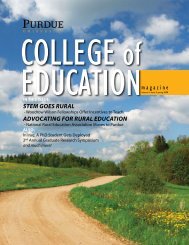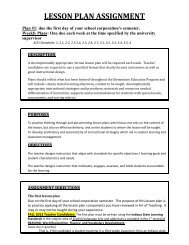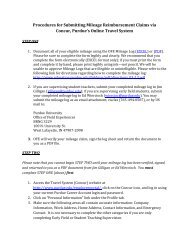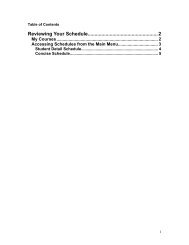No child left behind: Gifted children and school counselors.
No child left behind: Gifted children and school counselors.
No child left behind: Gifted children and school counselors.
You also want an ePaper? Increase the reach of your titles
YUMPU automatically turns print PDFs into web optimized ePapers that Google loves.
Marcia Gentry, Ph.D., isassociate professor ofeducational studies <strong>and</strong>associate director of the<strong>Gifted</strong> EducationResource Institute,Purdue University, WestLafayette, IN. E-mail:ingentry@purduc.eduThe author gratefullyacknowledges ChristineMcusfir her carefulreading of'this article.N® G AltC$BoCasA gifted-education researcher discusses the potentialeffects of'<strong>No</strong> Child Left Behind on gifted <strong>child</strong>ren <strong>and</strong>adolescents as well as implications for those who counselsuch <strong>child</strong>ren in public <strong>school</strong>s. With the primarypurpose ofstimulating thought, discussion, <strong>and</strong> action,she addresses the marginalization of gifted <strong>and</strong> otherat-risk <strong>child</strong>ren in the current educational climate<strong>and</strong> provides recommendations for <strong>school</strong> <strong>counselors</strong>./!fter working in education for 20 years as ateacher, coordinator, <strong>and</strong> professor, I attendedmy very first parent-teacher conference as a parent.My daughter attended kindergarten, <strong>and</strong> I waseager to learn about her performance in <strong>school</strong>. Herteacher had taught kindergarten for more than 20years <strong>and</strong> had a magical way of making her class of22 five-year-olds feel comfortable <strong>and</strong> happy. Whenit came time for our conference, I pulled the primary-sizedchair up to the primary-sized desk <strong>and</strong>sat across from the woman who was my daughter'sfirst teacher. She calmly explained that my daughterwas doing just fine in <strong>school</strong>, <strong>and</strong> then proceeded toreport how my daughter had performed, based onthe state st<strong>and</strong>ards identified for kindergarteners.She told me that my daughter could count to 10 <strong>and</strong>that by the end of the year, according to the st<strong>and</strong>ards,she would be able to count to 100. I quietlyasked if she had ever asked my daughter to count to100 <strong>and</strong> was told, "<strong>No</strong>, that st<strong>and</strong>ard isn't expecteduntil spring." She went on to explain that I hadnothing to worry about because my daughter hadmet all the st<strong>and</strong>ards. In other words, the teacherwas communicating that she had done her job.Never mind that my daughter had impressive mathematicalskills prior to kindergarten. The teacher hadnot checked out her existing skills or knowledge.Her job was to address the st<strong>and</strong>ards as dictated bythe <strong>No</strong> Child Left Behind Act (NCLB, 2001).In fact, my daughter could count, add, subtract,<strong>and</strong> explain fractions <strong>and</strong> negative numbers amongother benchmarks that did not exist in the state st<strong>and</strong>ardsfor kindergarteners. She asked me one day,"Would it be a tragedy if a person spent an entire dayon the planet <strong>and</strong> didn't learn anything new?" I hadto agree. As a second grader she continues to askwhen she will be given some hard work. However, Iwonder how many more years she will still want hardwork.In my daughter's new <strong>school</strong>, all of the studentswho scored poorly on the state test were encouragedto enroll in a 6-week course that met every daybefore <strong>school</strong> prior to the fall testing. This courseconcentrated on preparing the students for the statetest. Her <strong>school</strong> is touted to be a high-quality, blueribbon<strong>school</strong>, yet all curricular information senthome to parents emphasizes that everything done in<strong>school</strong> relates to the overarching state st<strong>and</strong>ards <strong>and</strong>to what is tested on a vearly basis.In another <strong>school</strong> that I visited, the principal hada consultant work with her staff for 2 days on"Strategies for Increasing Your School's TestScores." This consultant explained to a group ofconcerned inner-city teachers that they need notworry about the students who scored in the bottomquartile or about the students who scored in the topquartile, because the students in the middle had thepower to improve the most. She encouraged theteachers to give these "middle" students the mostattention if they wanted to improve their scores. Ineffect, the district <strong>and</strong> administration used taxpayerdollars to give the teachers permission not only toleave <strong>behind</strong> the lowest- scoring <strong>child</strong>ren, but also toignore the highest-scoring students.These examples provide little hope for studentswho may need extended, accelerated, or enrichedcurricula, or for the teachers who might be willing toprovide such modifications for their students. NCLB(2001) is, in effect, creating a climate of controlledlearning <strong>and</strong> sending a message to administrators,teachers, students, <strong>and</strong> parents that the <strong>school</strong>'s jobinvolves teaching to the st<strong>and</strong>ards-nothing more<strong>and</strong> nothing less. When students meet the st<strong>and</strong>ards,the <strong>school</strong>s have met their obligation to "educate."I begin with these examples because, in the wakeof NCLB (2001), students across the country incountless districts <strong>and</strong> classrooms experience the10:1 OCTOBER 2006 I ASCA 73
same quiet marginalization of their prior knowledge,<strong>and</strong> consequently of their future potential, as thest<strong>and</strong>ards have become the educational target. Infact, Johnson (2005) recently described a new law inTexas that rewards students who have shown proficiencyon the state test with 2 weeks off from <strong>school</strong>(during the <strong>school</strong> year) while teachers concentrateon preparing the other students for the test.In the following sections, I will address the effectsof NCLB (2001) on educational practice <strong>and</strong> thesubsequent marginalizing effect of these practices onthe education of gifted <strong>child</strong>ren. For each issueraised, I will recommend actions that <strong>school</strong> <strong>counselors</strong>,as leaders <strong>and</strong> advocates, can take to help<strong>school</strong> districts meet the needs of students alreadyidentified as gifted <strong>and</strong>, equally important, studentswho, with appropriate educational opportunities,might emerge as gifted. Because NCLB m<strong>and</strong>atestesting in major subject areas for students <strong>and</strong> usingtest results to determine if groups of students, teachers,<strong>and</strong> <strong>school</strong>s perform at proficient levels, <strong>school</strong>shave placed major emphases on testing, preparingfor the tests, <strong>and</strong> aligning curricula, programs,course offerings, <strong>and</strong> support services with the tests.These efforts may be detrimental to overall educationalprocesses, not only for high-performing students,but also for students from at-risk groups forwhom NCLB purports to deliver quality educationalopportunities (Gentry, in press). Most of theseidentified effects relate directly to the emphasis ontesting <strong>and</strong> accountability resulting from NCLB.EFFECT #1: FOCUS ON ONLY WHAT ISTESTEDA focus on only content tested leads to curricularreduction <strong>and</strong> an emphasis on test preparation, withtest performance itself seen as the educational outcome.This focus on content raises the question ofwhether the tests accurately <strong>and</strong> fairly measure whatthey purport to measure: student achievement.Curricular ReductionUnder NCLB (2001), districts must show adequateyearly progress on state assessments, which havebeen aligned with state st<strong>and</strong>ards. As a result, areasnot assessed by the high-stakes tests have been eliminatedby many districts-for example, electives,music, art, elementary science <strong>and</strong> social studies, foreignlanguage, gifted programs, <strong>and</strong> even elementaryrecess (Amrein & Berliner, 2002: Clarke et al.,2002; Kohn, 2000; Popham, 2001). All students,especially those from impoverished backgrounds,benefit from an enriched <strong>school</strong>ing experience.However, NCLB requirements push the focus awayfrom enrichment <strong>and</strong> toward preparing for requiredassessments. As curricular <strong>and</strong> programming optionsnarrow, <strong>and</strong> as <strong>school</strong>s define learning more <strong>and</strong>more narrowly, fewer <strong>and</strong> fewer students fit the<strong>school</strong>s (Eisner, 2001; Moon, Callahan, &Tomlinson, 2003). Moon et al. found that studentsfrom impoverished backgrounds were unlikely to beexposed to challenging curricula <strong>and</strong> instructionalmethods <strong>and</strong> suggested that the focus on testingrestricts educational opportunities for those most inneed. Rather than reaching more students, educatorsreach fewer students under NCLB.What Can School Counselors Do?With enhancing student achievement <strong>and</strong> accomplishmentas a primary goal of <strong>school</strong> counseling(Educational Trust, n.d.), <strong>counselors</strong> can advocatefor educating the whole <strong>child</strong> <strong>and</strong> for offering a richvariety of educational experiences (including electivesat the secondary level, the arts, <strong>and</strong> elementarysubjects such as science <strong>and</strong> history, in addition toreading <strong>and</strong> math) to develop gifts <strong>and</strong> talents in adiverse body of students. School <strong>counselors</strong> can helpadministrators <strong>and</strong> teachers underst<strong>and</strong> the need forrecess <strong>and</strong> exercise to promote cognition <strong>and</strong> learning(Hillman & Buck, 2004) <strong>and</strong> the need foradvanced programs for gifted students (U.S.Department of Education, 1993). For some <strong>child</strong>ren,electives, instruction differentiated to meettheir needs, or special programs may be their onlyavenue to feeling success <strong>and</strong> satisfaction in <strong>school</strong>.Time Spent Preparing for TestsWith high-stakes tests, educators spend more timepreparing for tests, with consequent detrimentaleffects on student learning, including decreasedgraduation rates, increased dropout rates, lowerscores on other nationally <strong>and</strong> internationally comparativetests of learning, <strong>and</strong> increased studentexpulsion <strong>and</strong> retention (Amrein & Berliner, 2002;Clarke et al., 2002; Moon et al., 2003; Pedulla et al.,2003). Preparing for tests is neither interesting normeaningful outside of the current <strong>school</strong> climate, yettoo many <strong>child</strong>ren <strong>and</strong> educators spend countlesseducational hours doing just that. In fact, in stateswith high-stakes graduation exams, overall academicachievement, as measured by ACT, SAT, <strong>and</strong>Advanced Placement scores, declined (Amrein &Berliner). Amrein <strong>and</strong> Berliner attributed thesedeclines to too much time spent teaching to thestate-required test <strong>and</strong> too little time on more substantivelearning. Such declines make entrance totop colleges <strong>and</strong> universities less likely, as universitiesdo not consider how well students perform on nonst<strong>and</strong>ardizedstate assessments. Gallagher (2004)pointed out that <strong>school</strong>s need gifted students' hightest scores to bolster the overall averages, <strong>and</strong>, withcurrent emphasis on inclusion, if average <strong>and</strong> belowaveragestudents are doing test-taking exercises,74 A5CA I PROFESSIONAL SCHOOL COUNSELING
then so are the gifted students. Time spent preparingfor tests takes time away from more meaningful,contextual learning.What Can School Counselors Do?School <strong>counselors</strong> can advocate against special "testpreparationworkshops" in favor of enriched learningexperiences that engage students <strong>and</strong> help themgenerate excitement about coming to <strong>school</strong>.Students' greater investment in <strong>school</strong> likely willtranslate into better attendance, greater ability tofocus, <strong>and</strong> enhanced learning, all likely to ultimatelyaffect test scores. By considering their charge ofdelivering learning opportunities that address academic,career, <strong>and</strong> personal <strong>and</strong> social development,<strong>school</strong> <strong>counselors</strong> can be instrumental in ensuringthat these important issues are not eclipsed by preparationfor assessments. They can advocate for thematic,interdisciplinary teaching rather than instructionof isolated skills. They can track performance onnational comparative measures such as collegeentrance exams <strong>and</strong> Advanced Placement exams <strong>and</strong>raise questions if these scores begin to decline. Theycan intervene with students who choose to dropout, learn what aspects of <strong>school</strong> did not benefitthem, <strong>and</strong> advocate for changes to better meet theirneeds. As an advocate for quality instruction, <strong>school</strong><strong>counselors</strong> can help their teacher colleagues have thecourage to teach important content in a manner thatengages <strong>and</strong> reaches students.Test Results Become the Target of EducationBy focusing on what is tested, educators have a cleartarget. However, if the target becomes the only end,then for students who already know the content orwho learn it rapidly, <strong>school</strong> becomes a series ofunchallenging exercises. For them <strong>and</strong> for other studentsas well, <strong>school</strong> becomes an uninspiring testpreparationmill. Sadly, this narrow means-to-endorientation leaves little room for what Eisner (2001)called "the development of intellectual dispositions• . . whe,re risk taking, exploration, uncertainty <strong>and</strong>speculation arc what it's about . . . curiosity <strong>and</strong>interest in engaging <strong>and</strong> challenging ideas" (p. 369).Yet under NCLB (2001), <strong>school</strong>s across the countryhave placed test scores as their indicator of quality<strong>and</strong> have focused their business of <strong>school</strong>ing on thetest-score target.High test scores are not necessarily indicative ofquality <strong>school</strong>s (Popham, 2001) <strong>and</strong> are correlatedwith socioeconomic status <strong>and</strong> other variables overwhich <strong>school</strong>s have little control (Barton, 2003;Kohn, 2001). In fact, quality <strong>school</strong>s reflect muchmore than high test scores. A recent national studyfor the National Center on Educational Statisticsidentified 13 quality-<strong>school</strong> indicators from recentresearch related to student learning, including theskills, assignments, <strong>and</strong> experiences of teachers; classsize; use of technology; curriculum content <strong>and</strong>instructional pedagogy; <strong>and</strong> <strong>school</strong> leadership goals<strong>and</strong> learning environment-<strong>and</strong> none of the indicatorsincluded test scores (Mayer, Mullens, & Moore,2000).What Can School Counselors Do?Working with staff <strong>and</strong> students to assess <strong>school</strong> climate<strong>and</strong> affective variables could help to inform the<strong>school</strong> about factors that contribute to quality<strong>school</strong> experiences for students. The "right" environmentis one that is conducive to learning, <strong>and</strong> ifthe sole focus of the assessment is a test, which by itsvery nature fails to account for the environment,then it follows that both areas of excellence <strong>and</strong>areas needing improvement may be overlooked.School <strong>counselors</strong> might encourage others to reportareas of achievement that reach beyond the testscores. For example, in what projects are students<strong>and</strong> teachers engaged? Are there opportunities forservice learning, mentorships, <strong>and</strong> apprenticeships,<strong>and</strong> are these opportunities integrated into academicplanning with individual students? What activitiesare students involved in to develop leadership, creativity,<strong>and</strong> problem solving, <strong>and</strong> what are the effectsof these activities on student engagement, learning,<strong>and</strong> <strong>school</strong> satisfaction?Tests of Questionable ValidityMany of the tests in use by states to measure adequateyearly progress under NCLB (2001) yieldscores of dubious validity (Popham, 2001; Smith &Fey, 2000), which correlate with socioeconomic status<strong>and</strong> shallow thinking (Kohn, 2000). Such scoresmay simply predict other test scores while having littleto do with measuring actual student achievement(Popham). When the stakes are high, according toNichols <strong>and</strong> Berliner (2005), the meaning of thescores becomes questionable at best <strong>and</strong> uninterpretableat worst. These issues illuminate the dangerof placing too much emphasis on limited, highstakesmeasures of "achievement." Such emphasiscan serve to undermine quality <strong>school</strong>ing (Popham),leaving gifted <strong>and</strong> other students locked into a systemthat cares more about test scores than actualstudent learning.What Can School Counselors Do?Because <strong>school</strong> <strong>counselors</strong> may be involved in theselection <strong>and</strong> reporting, <strong>and</strong> often in the interpretation,of cognitive, aptitude, <strong>and</strong> achievement tests,they might want to determine <strong>and</strong> share what validity<strong>and</strong> reliability evidence exists for the NCLB(2001) measures. In some instances, states use criterionassessments that have had little or no psychometricwork on their validity <strong>and</strong> reliability. School<strong>No</strong> Child LeftBehind is, in effect,creating a climateof controlledlearning <strong>and</strong>sending a messagethat the <strong>school</strong>'s jobinvolves teaching tothe st<strong>and</strong>ardsnothingmore <strong>and</strong>nothing less.10:1 OCTOBER 2006 I ASCA 75
unfair comparisons of unequal groups as well asmask individual student differences. The focus onmeasurable st<strong>and</strong>ards <strong>and</strong> proficiencies for all studentshas led to the erosion of challenge for giftedstudents.Same St<strong>and</strong>ards for AllInherent in NCLB (2001) is the assumption thatmore students can perform at higher levels, <strong>and</strong> thisis certainly true. In practice, however, this assumptionhas been interpreted to mean that all studentswill become proficient using the same grade-levelst<strong>and</strong>ards, whether they are ready or whether theyalready know it. This one-size expectation fails toaccount for individual differences on variables linkedto performance over which <strong>school</strong>s exert little control,such as socioeconomic status, environmentalexperiences, aptitude, <strong>school</strong> readiness, <strong>and</strong> homeenvironment (Barton, 2003; Kohn, 2000; Ohanian,1999; Popham, 2001).Further, it has been well documented that studentsfrom poverty suffer from "summer loss" inachievement, whereas their middle-class counterpartsgain during the summer months (Bracey,2002; Entwisle, Alex<strong>and</strong>er, & Olson, 2000).Children vary in their learning rates, their aptitudes,their backgrounds, <strong>and</strong> their experiences. To expectsameness defies the ability of educators to nurture<strong>child</strong>ren as unique individuals. Some students needmore <strong>and</strong> others need less (Vygotsky, 1962), <strong>and</strong> allneed to believe that they can do what they are beingasked to do (B<strong>and</strong>ura, 1997). Responsiveness toindividual differences requires measures that alloweducators to see students as individuals.With one-size-fits-all st<strong>and</strong>ards, <strong>and</strong> under theauspices of NCLB (2001), no one is being asked toshow growth of individual students. Instead, educatorsare being asked to show group comparisons <strong>and</strong>"adequate yearly progress" for various groups of<strong>child</strong>ren. With this approach, individual studentsbecome lost, <strong>and</strong> the environment created is notconducive to enhancing the achievement of giftedstudents or the achievement of students who havepotential for high academic achievement in specificcontent areas. NCLB has created an environment inwhich <strong>school</strong> administrators have no incentive toconcentrate on educating gifted <strong>child</strong>ren or developingtalents of individual <strong>child</strong>ren. It will take yearsbefore we know the actual effects of this legislation,but early studies <strong>and</strong> observations are not encouraging(e.g., Amrein & Berliner, 2002; Moon et al.,2003; Nichols & Berliner, 2005).What Can School Counselors Do?The most important role that a <strong>school</strong> counselormight play is as an advocate for individual studentlearninggains. Educators can <strong>and</strong> should be heldresponsible for ascertaining where individual studentsbegin <strong>and</strong> how much progress they make duringtheir <strong>school</strong> experience. The use of gain scoresfor individual students can do much to alleviate theinclination to compare only group scores. Accordingto ASCA (2005), appropriate tasks for a <strong>school</strong>counselor are interpreting student records as well asinterpreting cognitive, aptitude, <strong>and</strong> achievementtests. School <strong>counselors</strong> could actually begin a trendthat keeps the focus on individual students' gains,rather than on group-to-group comparative scores.Changing testing from fall to spring, or testing inthe fall <strong>and</strong> again in the spring, <strong>and</strong> using a measurewithout a ceiling would help to facilitate underst<strong>and</strong>ingof individual gains.Lack of ChallengeNeihart (2002) discussed the importance of appropriatechallenge for <strong>child</strong>ren. Challenge is difficult toexperience in a system that promotes grade-levelst<strong>and</strong>ards <strong>and</strong> group assessment of these st<strong>and</strong>ards.According to Neihart, appropriate challenge in<strong>school</strong> can alleviate many other social <strong>and</strong> emotionalconcerns for gifted <strong>child</strong>ren. Without challenge,gifted <strong>child</strong>ren do not learn to struggle, to persevere,to work hard, <strong>and</strong> to attribute their success tohard work, among other important lessons thatcome with meeting a challenge. NCLB (2001) failsto encourage educators to provide appropriate levelsof challenge for these students. Such a system placesgifted students at serious risk of underachievement,in terms of realizing their potential. The societalimplications of undereducating <strong>and</strong> underdevelopingtalented youth in our educational system aresobering. It will be these youth who will solve, or failto solve, important problems in the future(Davidson, Davidson, & V<strong>and</strong>erkam, 2004). A society'svalue <strong>and</strong> ability to contribute to globalhumanity rest with its youth <strong>and</strong> with its ability toprepare its youth for productive citizenry.What Can School Counselors Do?School <strong>counselors</strong> might consider interventions forstudents who experience boredom due to unchallengingcurricular opportunities. For example, a<strong>school</strong> counselor might assist in the implementationof preassessment <strong>and</strong> the development of otheroptions for students who already know or who canlearn the curriculum in content areas quickly. Is itpossible for students to test out of a class in whichthey already know the content, or is seat timerequired for credit? A <strong>school</strong> counselor could promotedialogue about such an important concern <strong>and</strong>influence policy. School <strong>counselors</strong> also be mightinstrumental in encouraging their teaching colleaguesto consider the importance of challenge fortheir students by providing information concerning78 ASCA I PROFESSIONAL SCHOOL COUNSELING
the social <strong>and</strong> emotional benefits of experiencingappropriate levels of challenge in <strong>school</strong>. Finally,concerning challenge, <strong>school</strong> <strong>counselors</strong> can helpindividual students <strong>and</strong> small groups of students tounderst<strong>and</strong> the need to embrace challenge <strong>and</strong>develop strategies for self-advocacy as they seekappropriate challenges in <strong>school</strong>.EFFECT #4: CHEATING AND THEMESSAGE TO STUDENTSMany instances of cheating by educators in responseto high-stakes testing have been noted in the media.Popham (2001, p. 22) called this "test-pressuredcheating," <strong>and</strong> Nichols <strong>and</strong> Berliner (2005) notedthat higher stakes mean that the meaning of thescores becomes increasingly questionable. Countlessaccounts of cheating have been reported, probablythe most egregious surrounding the sc<strong>and</strong>als inTexas (CBS News, 2004; Dobbs, 2003; Haney,2000; Schemo, 2003), but all reflect the intensepressure put on educators, <strong>and</strong> thus on students, toproduce results on NCLB tests. Furthermore, in themany <strong>school</strong>s where blatant cheating does not exist,more subtle forms of corrupt test preparation canexist (Clarke et al., 2002; Nichols & Berliner, 2005).Troubling is the message that cheating sends to thestudents: that the end justifies the means. Whenadults cheat or engage students in inappropriate testpreparation exercises to create a testing advantage,they suggest to their students that high scores areworth compromising values. That message reflects alack of integrity in the very people who shouldmodel integrity, honesty, <strong>and</strong> ethics.Like their teachers <strong>and</strong> administrators, studentsface increasing pressure to increase performance onthe tests. The risk exists that <strong>child</strong>ren will judge thattheir worth is based on their test scores. In addition,as educators emphasize the importance of the testing,student anxiety increases (Jones et al., 1999).For a student who does not perform well on tests<strong>and</strong> who is placed into remedial or test preparationclasses, self-image can become a problem, efficacycan wane, <strong>and</strong> achievement can decrease. Testsbecome more important than learning when learningis reduced to a series of exercises in which studentslearn content <strong>and</strong> then select the rightanswers on an accountability assessment-regardlessof probable public perceptions, the "learning"can be reduced to test scores. The message becomes"You are what you score," a sad message for thestudent who does not score well. There are inherentdangers when, due to the pressure from NCLB(2001), educators become preoccupied withpreparing students for the test rather than educatingthem for productive lives.<strong>Gifted</strong> <strong>child</strong>ren often are more attuned to complexissues related to justice <strong>and</strong> fairness than theirage peers are (Neihart, 2002) <strong>and</strong> thus may find itdifficult to reconcile a teacher's "helping" them witha test in the case of corrupt test-preparation practices.They may more readily pay attention to <strong>and</strong>struggle with a news story concerning educatorswho cheat in the enterprise of state testing. Theyalso may feel more responsibility to score well <strong>and</strong>experience more disappointment <strong>and</strong> guilt whenthey do not score well. This may be especially trueof those students who have learning disabilities,which coexist with intellectual giftedness. Whenthey then face less challenge <strong>and</strong> more rote preparation,underachievement may result (Patrick et al.,2006).What Can School Counselors Do?As <strong>school</strong> <strong>counselors</strong> work with teachers on guidancecurriculum lessons or advisor-advisee programs(ASCA, 2005) <strong>and</strong> with students on personal <strong>and</strong>social issues, they can address integrity <strong>and</strong> ethics<strong>and</strong> can help students focus more on learning thanon test results. School <strong>counselors</strong> can help othersunderst<strong>and</strong> how high-stakes messages to students<strong>and</strong> emphasis on tests can be detrimental to students'sense of learning, progress, <strong>and</strong> efficacy(Eisner, 2001). School <strong>counselors</strong> can take the leadin helping others underst<strong>and</strong> individual gain scores.Finally, they can assist students <strong>and</strong> colleagues withputting high-stakes accountability concerns into perspectiveby focusing on what education can do tohelp students be <strong>and</strong> become productive citizens inour democracy.SUMMARYThese are troubled times in education, <strong>and</strong> evenmore troubled times in gifted education, with thenarrow focus brought to education by NCLB(2001). <strong>Gifted</strong> <strong>child</strong>ren exist in all of our <strong>school</strong>s, asalso do students of untapped <strong>and</strong> unrecognizedpotential. Yet, under NCLB, despite its intention to"leave no <strong>child</strong> <strong>behind</strong>," more <strong>and</strong> more <strong>child</strong>renare marginalized in a bare-bones educational system.Services to gifted <strong>child</strong>ren have been cut, <strong>and</strong> funds,in contrast, have been allocated to remediate students.Students drop out at alarming rates in a systemthat focuses not on their possibilities but ontheir weaknesses. When poorly performing studentsleave <strong>school</strong>s, administrators, under great pressureto report improved test scores, may actually berelieved because the absence of low-performing studentshelps the bottom-line average test score.Then, with fear of being labeled failing, educatorsunderreport or de-emphasize these dropouts, <strong>and</strong>more <strong>and</strong> more <strong>child</strong>ren for whom the legislationwas intended are not only <strong>left</strong> <strong>behind</strong>, but areStudents' greaterinvestment in<strong>school</strong> likely willtranslate intobetter attendance,greater ability tofocus, <strong>and</strong> enhancedlearning, all likelyto ultimately affecttest scores.10:1 OCTOBER 2006 I ASCA 79
The most importantrole that a <strong>school</strong>counselor mightplay is as anadvocate forindividual studentlearninggains.pushed out of the system, which no longer has anything<strong>left</strong> to offer them.The first step to solving a problem is recognizingthe problem. The vignettes with which I began thisarticle are real examples of the effects of NCLB(2001). There are many more such examples incountless <strong>school</strong>s across the country as educatorsstruggle to find meaningful focus in the chaos of thelargest federal education initiative ever. Interventionfor individual students <strong>and</strong> quality education foridentified gifted, at-risk, <strong>and</strong> underidentified gifted<strong>and</strong> at-risk students begins with one educator <strong>and</strong>one <strong>child</strong> at a time. It seems that <strong>school</strong> <strong>counselors</strong>are in a unique position not only to work with <strong>child</strong>ren,but also to bring to the table conversationsconcerning some of the issues raised herein. IReferencesAmerican School Counselor Association. (2005). TheASCAnational model: A framework for <strong>school</strong> counseling programs(2nd ed.). Alex<strong>and</strong>ria, VA: Author.Amrein, A. L., & Berliner, D. C. (2002). An analysis of some unintended<strong>and</strong> negative consequences of high-stakes testing.Tempe: Arizona State University, Educational PolicyStudies Laboratory. (EPSL <strong>No</strong>. 0211-125-EPRU)B<strong>and</strong>ura, A. (1997). Self-efficacy. New York: W.H. Freeman.Barton, P. (2003). Parsing the achievement gap. Princeton, NJ:Educational Testing Service.Bloom, B. (1985). Developing talent in young people. New York:Ballantine.Borders, D. L., & Drury, S. M. (1992). Comprehensive <strong>school</strong>counseling programs: A review for policymakers <strong>and</strong>practitioners. Journal of Counseling <strong>and</strong> Development, 70,487-498.Bracey, G. (2002, January 16). What they did on vacation: It'snot the <strong>school</strong>s that are failing. The Washington Post, p.A19.CBS News. (2004, January 7). The Texas miracle. RetrievedJanuary 23, 2004, from http://www.cbsnews.com/stories/2004/01/06/6011/printable591676.shtmlClarke, M., Shore, A., Rhoades, K., Abrams, L., Maio, J., & Li, J.(2002). Perceived effects of state-m<strong>and</strong>ated testing programson teaching <strong>and</strong> learning: Findings from interviewswith educators in low-, medium-, <strong>and</strong> high-stakes states.Boston: Boston College, National Board on EducationalTesting <strong>and</strong> Public Policy.Colangelo, N., Assouline, S. G., & Gross, U. M. (2004).A nationdeceived: How <strong>school</strong>s hold back America's brightest students.Iowa City, IA: Connie Belin & Jacqueline N. BlankInternational Center for <strong>Gifted</strong> Education <strong>and</strong> TalentDevelopment.Davidson, J., Davidson, B., & V<strong>and</strong>erkam, L. (2004). Geniusdenied: How to stop wasting our brightest young minds.Riverside, NJ: Simon & Schuster.Dobbs, M. (2003, <strong>No</strong>vember 8). Education "miracle" has a mathproblem. The Washington Post, p. Al.Educational Trust. (n.d.). Transforming <strong>school</strong> counseling.Retrieved January 13,2006, from http://www2.edtrust.org/EdTrust/Transforming+School+Counseling/mainEisner, E. (2001).What does it mean to say a <strong>school</strong> is doingwell? Phi Delta Kappan, 82,367-372.Elmore, R. F. (2003). A plea for strong practice. EducationalLeadership, 61(3), 6-10.Entwisle, D. R., Alex<strong>and</strong>er, K. L., & Olson, L. S. (2000). Summerlearning <strong>and</strong> home environment. In R. D. Kahlenberg(Ed.), A notion at risk: Preserving public education as anengine for social mobility (pp. 9-30). New York: CenturyFoundation Press.Gallagher, J.J. (2004). <strong>No</strong> Child Left Behind <strong>and</strong> gifted education.Roeper Review, 26,121-123.Gentry, M. (in press). <strong>No</strong> Child Left Behind: Neglecting excellence.Roeper Review.Gentry, M., & Gable, R. K. (2001). My class activities: Technicalmanual. Mansfield Center, CT: Creative Learning Press.Golden, D. (2004, December 29). Initiative to leave no <strong>child</strong><strong>behind</strong> leaves out gifted. The Wall Street Journal, p. Al.Haney, W. (2000).The myth of the Texas miracle in education.Education Analysis Policy Archives, 8(41). Retrieved<strong>No</strong>vember 10, 2005, from http://epaa.asu.edu/epaa/v8n41Hillman, C., & Buck, S. (2004, October). Physical fitness <strong>and</strong> cognitivefunction in healthy preadolescent <strong>child</strong>ren. Paperpresented at the annual meeting of the Society forPsychophysiological Research, Santa Fe, NM.Hunt, J. B., & Carroll, T. G. (2003). <strong>No</strong> dream denied:A pledge toAmerica's <strong>child</strong>ren. Washington, DC: National Commissionon Teaching <strong>and</strong> America's Future.Johnson, S. (2005). Furlough from <strong>school</strong>? <strong>Gifted</strong> Child Today,28, 5.Jones, M. G., Jones, B. D., Hardin, B., Chapman, L., Yarbrough, T., &Davis, M. (1 999).The impact of high-stakes testing onteachers <strong>and</strong> students in <strong>No</strong>rth Carolina. Phi DeltaKappan, 81, 109-203.Kohn, A. (2000). The case against st<strong>and</strong>ardized testing: Raisingthe scores, ruining the <strong>school</strong>s. Portsmouth, NH:Heinemann.Kohn, A. (2001). Fighting the tests: A practical guide to rescuingour <strong>school</strong>s. Phi Delta Kappan, 82, 349-357.Mayer, D. R, Mullens, J. E., & Moore, M.T. (2000). Monitoring<strong>school</strong> quality:An indicators report. Washington, DC: U.S.Department of Education, National Center for EducationStatistics.MoonT. R., Callahan, C. M., & Tomlinson, C. A. (2003). Effects ofstate testing programs on elementary <strong>school</strong>s with highconcentrations of student poverty-good news or badnews? Current Issues in Education, 6(8). Retrieved<strong>No</strong>vember 10, 2005, from http://cie.ed.asu.edu/volume6/number8/National Association for <strong>Gifted</strong> Children. (2005). State of thestates 2004-2005. Washington, DC: Author.Neihart, M. (2002). Risk <strong>and</strong> resilience in gifted <strong>child</strong>ren: A conceptualframework. In M. Neihart, S. M. Reis, N. M.Robinson, & S. M. Moon (Eds.), The social <strong>and</strong> emotionaldevelopment of gifted <strong>child</strong>ren (pp. 113-122). Waco, TX:Prufrock Press.Neill, M. (2003). Leaving <strong>child</strong>ren <strong>behind</strong>: How <strong>No</strong> Child LeftBehind will fail our <strong>child</strong>ren. Phi Delta Kappan, 85,225-228.Nichols, S. L., & Berliner, D. C. (2005). The inevitable corruption ofindicators <strong>and</strong> educators through high-stakes testing.Tempe: Arizona State University, Educational PolicyStudies Laboratory. (EPSL <strong>No</strong>. 0503-101 -EPRU)<strong>No</strong> Child Left Behind Act of 2001, Pub. L. <strong>No</strong>. 107-110.Retrieved January 13,2006, from http://www.ed.gov/legislation/ESEA02/Ohanian, S. (1999). One size fits few: The folly of educationalst<strong>and</strong>ards. Portsmouth, NH: Heinemann.80 ASCA I PROFESSIONAL SCHOOL COUNSELING
Patrick, H., Gentry, M., & Owen, S.V. (2006). Motivation <strong>and</strong> giftedadolescents. In F. Dixon & S. M. Moon (Eds.), The h<strong>and</strong>bookof secondary gifted education (pp. 165-195). Waco,TX: Prufrock Press.Pedulla, J., Abrams, L., Madaus, G., Russell, M., Ramon, M., &Miao, J. (2003). Perceived effects of state-m<strong>and</strong>ated testingprograms on teaching <strong>and</strong> learning: Findings from anational survey of teachers. Boston: Boston College,National Board on Educational Testing <strong>and</strong> Public Policy.Popham, W. J. (2001). The truth about testing:An educator's callto action. Alex<strong>and</strong>ria, VA: Association for Supervision <strong>and</strong>Curriculum Development.Renzulli, J. S. (1994). Schools for talent development. MansfieldCenter, CT: Creative Learning Press.Schemo, D.J. (2003, July 26). Education secretary defends<strong>school</strong> system he once led. The New York Times. RetrievedJanuary 23,2004, from http://www.pipeline.com/-rgibson/paigeonhouston.htmlSmith, M. L., & Fey, P. (2000).Validity <strong>and</strong> accountability in highstakestesting.Journal of Teacher Education, 51, 334-344.Tomlinson, C. A. (2002, <strong>No</strong>vember 6). Proficiency is not enough.Education Week, 22, 36-68.U.S. Department of Education. (1993). National excellence: Thecase for developing America's talent. Washington, DC:Government Printing Office, Office of EducationalResearch <strong>and</strong> Improvement.Vygotsky, L. S. (1962). Thought <strong>and</strong> language. Cambridge, MA:MIT Press.Whiston, S., & Sexton,T. (1998). A review of <strong>school</strong> counselingoutcome research: Implications for practice.Journal ofCounseling <strong>and</strong> Development, 76, 412-426.Earn CEUs for reading this article.Visit www.<strong>school</strong>counselor.org, <strong>and</strong>click on Professional School Counselingto learn how.10:1 OCTOBER 2006 I ASCA 81
COPYRIGHT INFORMATIONTITLE: <strong>No</strong> Child Left Behind: <strong>Gifted</strong> Children <strong>and</strong> SchoolCounselorsSOURCE: Professional School Counseling 10 no1 O 2006PAGE(S): 73-81WN: 0627405985014The magazine publisher is the copyright holder of this article <strong>and</strong> itis reproduced with permission. Further reproduction of this article inviolation of the copyright is prohibited.Copyright 1982-2006 The H.W. Wilson Company. All rights reserved.



